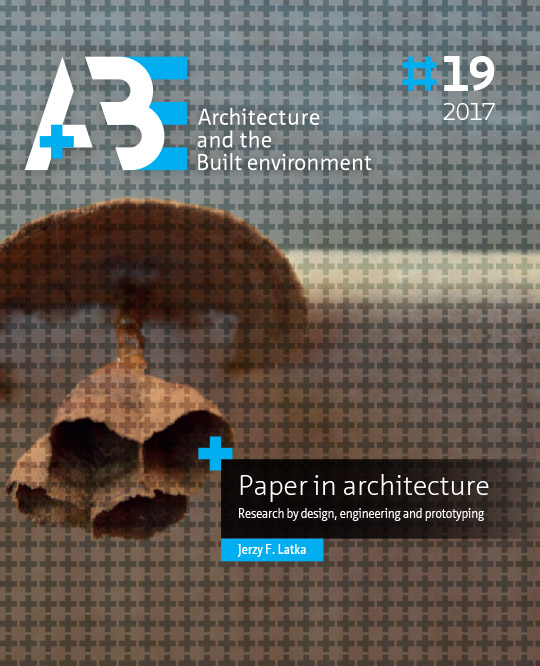Introduction
DOI:
https://doi.org/10.7480/abe.2017.19.3755Abstract
Paper is a universally found, easily available material of natural origin. It is cheap in production, eco-friendly and easy to recycle and re-use.
Paper has been part of European culture since the twelfth century, when it arrived from the Arab countries through the Iberian Peninsula. Since then it has become a common material, occurring in many different variants and forms: books, greaseproof paper, wallpaper, posters, playing cards, etc. Despite the fact that this ‘evolved wood’, as Shigeru Ban calls it, is so widely used in other spheres of life, we relatively rarely come across it in the building industry. Paper and cardboard are hardly ever regarded as an independent material or primary construction material.
Actually realised examples of architecture using paper as a main construction material have proved that it is suitable for usage in temporary as well as permanent construction. By exploring the physical structure of paper, as well as its properties and ways to improve these, we can manufacture building components that can be used for the construction of buildings made of paper and its derivatives. Since paper is widely available, affordable and environmentally friendly, it should be recognised as a building material of the future, for the right kinds of buildings with the right kinds of functions.
Take, for instance, the cardboard constructions built by the homeless and refugees. Homeless people use whatever packaging materials they can get hold of in order to construct makeshift shelters in which they are able to survive successive nights in minimal thermal and atmospheric comfort. Paper products can be easily used to create cheap shelters for homeless and roofless people living in European cities, but they have also been used for homeless and roofless people in places such as Japan or Haiti, where thousands of people lost their homes as a result of natural disasters. Conflict zones like Syria or Ukraine need inexpensive residential structures that can serve as shelters for refugees, but refugees who have made their way to Europe could also be accommodated in individual cardboard shelters. Paper and its derivatives can also be used to build permanent lightweight shelters, suitable for transport by water, land or air, to be used in the most endangered and poorest parts of the world, such as certain countries in Africa, Asia and South America.
Temporary paper buildings can also fulfil the needs of inhabitants of developed countries. ‘Neo-nomadism’, i.e. the phenomenon whereby people migrate in search of jobs, attractions and opportunities presented by other places, the way nomadic people like the Roma have been doing for centuries, is increasingly common. As a result, more and more mobile solutions are required, in the sphere of architecture as elsewhere. Temporary structures built in specifically designated areas, parts of a city that are temporarily not used, “breaches” created as a result of demolished buildings, districts which are not completely built up or discontinued construction sites can fulfil housing needs, thus becoming part of the state of ‘liquid modernity’. [1]
Paper can be used in architecture in many ways. Not only can paper-based materials, such as cardboard, paper tubes and honeycomb panels, be used as building materials for architectural structures, but they can also be used in interior design, furnituremaking, industrial design objects and art. With its long tradition, which dates back all the way to the second century AD, paper is a material that is deeply rooted in European culture and particularly in Far Eastern culture. [2]
In order to be able to determine the possible range of the use of paper, people seeking to work with paper must study its structure, basic physical and chemical properties and the ways in which these can be affected. The greatest threat to paper is humidity. Water causes the bonds between the fibre molecules to break, thus turning paper into pulp, which will lose the physical properties essential for load-bearing structures, such as strength and stiffness. Other potentially destructive threats to structures made of paper include fire, fungi and insects. The aforementioned threats can be removed by applying the right type of impregnation to building components made of paper.
The belief that paper can successfully be used as an architectural material, which has been confirmed by successful projects realised all over the world, as well as the author’s personal experience with paper as an architectural material, was the main reason why the author of this dissertation took up the subject of testing the properties of paper to be used as a material for building components.

